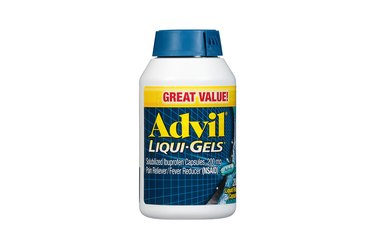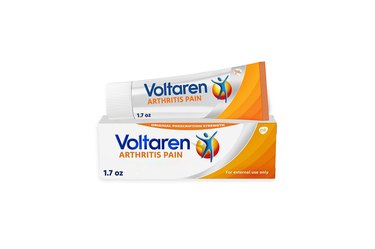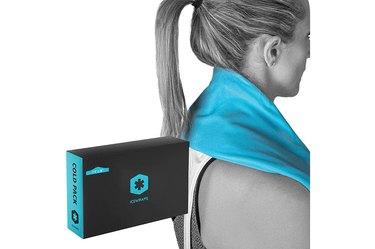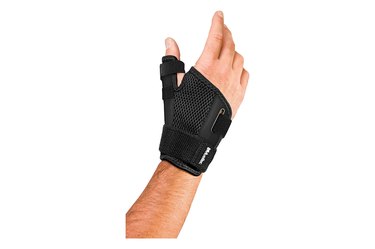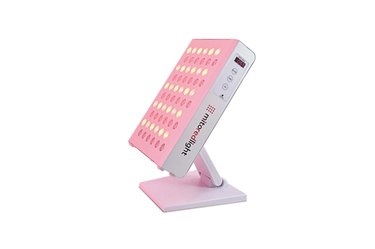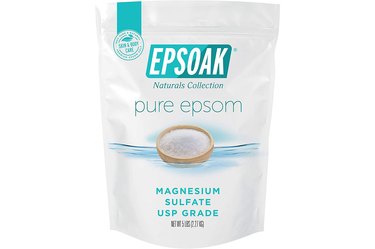
Tendons are the tissues that connect your muscles to your bones throughout your body. When they become inflamed or irritated, you'll feel tenderness and pain of tendonitis, says Brynna Connor, MD, a board-certified family medicine physician and health care ambassador for NorthWestPharmacy.com.
Generally speaking, tendonitis (sometimes spelled tendinitis) most frequently appears around the joints we use most often — the wrists, elbows, shoulders, Achilles tendon/heel and knees — but you might also get tendonitis at your thumbs or hips.
Video of the Day
Video of the Day
"Tendonitis can be caused when some harsh or violent strain occurs on a tendon, or when someone moves their body in a way that it is not used to," Dr. Connor says. "Common activities that cause tendonitis are sports, gardening, remodeling your home, cleaning or repetitive movements."
If you have tendonitis, the first step is to book a check-up with your doctor. This is to rule out any more serious injury requiring medical attention.
Once you're cleared, try these over-the-counter treatments for tendonitis to ease some of your pain and help those tendons heal.
1. Best Anti-Inflammatory Medication: Advil Liqui-Gels
One of the most common ways people treat soreness is to take pain relievers. For tendonitis specifically, you should look for non-steroidal anti-inflammatory drugs or NSAIDs, says Joan Rubinger, FNPC, PhD, CSCS, board-certified nurse practitioner, certified strength and conditioning coach and founder of All Pro Sports Medicine.
"These medications aim to reduce inflammation and related symptoms by neutralizing the inflammatory response in the body," Rubinger explains.
Advil's active ingredient is ibuprofen, which you can also find in Motrin. Another NSAID is naproxen, found in Aleve. Stay away from Tylenol, though: Its active ingredient is acetaminophen, which addresses pain but not inflammation.
Buy it: Amazon.com; Price: $16 for 200 capsules
2. Best Topical: Voltaren Gel
Applying certain anti-inflammatory gels and creams can provide near-instant relief when you have tendonitis.
Your best bet is this highly rated topical treatment that used to be a prescription, but is now available over-the-counter, says Arianne Missimer, DPT, CSCS, physical therapist and founder and CEO of The Movement Paradigm.
"This non-steroidal anti-inflammatory gel has been clinically proven to reduce pain associated with acute inflammatory conditions such as tendonitis," she explains.
Apply three to four times a day to the affected area for best results.
Buy it: Amazon.com; Price: $19.32
3. Best Cold Pack: IceWraps Cold Therapy
Because tendonitis is caused by inflammation often resulting in swelling, icing the affected area will go a long way in treating your pain and assisting in the healing process, Dr. Connor says.
For the best relief, alternate between icing for 15 to 20 minutes and removing the ice for the same amount of time several times throughout the day.
For tendonitis, Dr. Connor particularly likes large, reusable ice packs with cloth coverings because they're comfortable and much easier to wrap around awkward areas like knees and shoulders.
Buy it: Amazon.com; Price: $23
4. Best Compression Therapy: Mueller Thumb-Stabilizing Brace
Compression that comes with reusable elastic bandages or stabilizing braces is helpful to hold your joint still and prevent movement that can aggravate the injury and prevent healing, Dr. Connor says.
"While you have swelling, you can use these compression methods, but never wrap too tightly," she continues. "You don't want to see any skin discoloration because that indicates the restriction of blood flow, which can be dangerous and will also slow healing."
You can go with classic elastic bandages for knees and elbows ($11.95 for 4, Amazon.com), but if you have tendonitis in your thumb, Dr. Connor says a brace like this will work very well in stabilizing your joint while your injury heals.
Buy it: Amazon.com; $11
5. Best Heat Therapy: MitoPro 300
Missimer says red-light therapy is one of the trendiest ways to reduce inflammation after a hard workout or periods of acute injury such as tendonitis.
"Elite athletes, trainers and biohackers are a big fan of this safe and effective rehab and recovery technique," she explains.
You can book red-light sessions at wellness clinics or purchase smaller, at-home products. For the latter, she recommends the MitoPro 300, which is more affordable than many others and ideal if you're someone who works out frequently.
She adds that being very consistent with red-light therapy is important, and you'll see the best results if you do it every day for 15 minutes.
Buy it: MitoRedLight.com; $329
6. Best Rest Therapy: Epsoak Pure Epsom Salt
If you ask Dr. Connor, nothing beats rest when it comes to tendonitis treatment. In fact, she says it's essential to allow for the swelling to go down and for healing to occur.
While you can still exercise and move as long as you're not straining the injured tendon, it's vital to proceed with caution.
"If you have tendonitis in your knee or ankle and still want to stay active, try gentle swimming or working out your upper body while seated. If your shoulder or elbow is injured, go for a walk," she continues. "Until your doctor approves you to go back to normal activity levels, though, be very gentle with the injured area."
One ritual that may feel extra-soothing is taking a warm bath. Not only will you relax, but floating takes the pressure off of your body, too.
To add extra benefit, Missimer suggests tossing in Epsom salts. These are ultra-healing because they contain a high concentration of magnesium. "This mineral supports lymphatic circulation and has natural anti-inflammatory properties," she explains.
Add two cups of Epsom salts and soak for 20 minutes several times a week for best results.
Buy it: Amazon.com; $28 for 19 lbs
What to Look for in OTC Tendonitis Treatments
1. Affected Area
The right treatment for you may depend on where the tendonitis is in your body. For example, a compression brace makes more sense if the tendonitis is in your thumb, while an elastic bandage will work better if the pain and swelling is in your knee or elbow.
The same is true for topical creams and gels, which might not be comfortable on your wrist if, say, you're typing on a keyboard all day.
2. Active Ingredients
As with any medicine or topical treatments, make sure you pay attention to the back label before use. If you are sensitive to certain active ingredients, you'll want to avoid anything that could cause upset or harm. It's also important to note that various tendonitis treatments have different textures and smells, which could be tricky if you're sensitive.
3. Cost
NSAIDs, ice packs and compression gear are relatively inexpensive, and you could buy a few of them at once to test what works best for your needs. On the other hand, at-home heat therapy can be pricey, so consider consulting with your doctor before investing.
When to See a Doctor
There are various levels of severity when your tendons are inflamed or injured. While OTC treatments will be helpful in most cases, sometimes they aren't enough, says Robert Parisien, MD, an orthopedic sports medicine surgeon at Mount Sinai and the team physician for the U.S. Ski & Snowboard and Fencing Olympic teams.
When OTC treatments aren't working or may not be enough, he says a physical examination may reveal:
- Decreased range-of-motion secondary to pain
- Focal swelling and thickening of the tendon
- Bony spurs at the tendon-bone junction
- Pain with direct palpation at the involved site
- Reproducible pain with attempted activation of the tendon against resistance
If your pain isn't going away or changing within a few weeks, don't hesitate to book an appointment with your physician.
- American Family Physician: Common Overuse Tendon Problems: A Review and Recommendations for Treatment
- Merck Manual Professional Version: Tendinitis and Tenosynovitis
- Family Practice Notebook: Local Heat Therapy
- Sports Health: Evaluation and Management of Elbow Tendinopathy
- U.S. Food and Drug Administration: Medication Guide For Non-Steroidal Anti-Inflammatory Drugs (NSAIDs)
- Merck Manual Professional Version: Achilles Tendinitis
Is this an emergency? If you are experiencing serious medical symptoms, please see the National Library of Medicine’s list of signs you need emergency medical attention or call 911.
